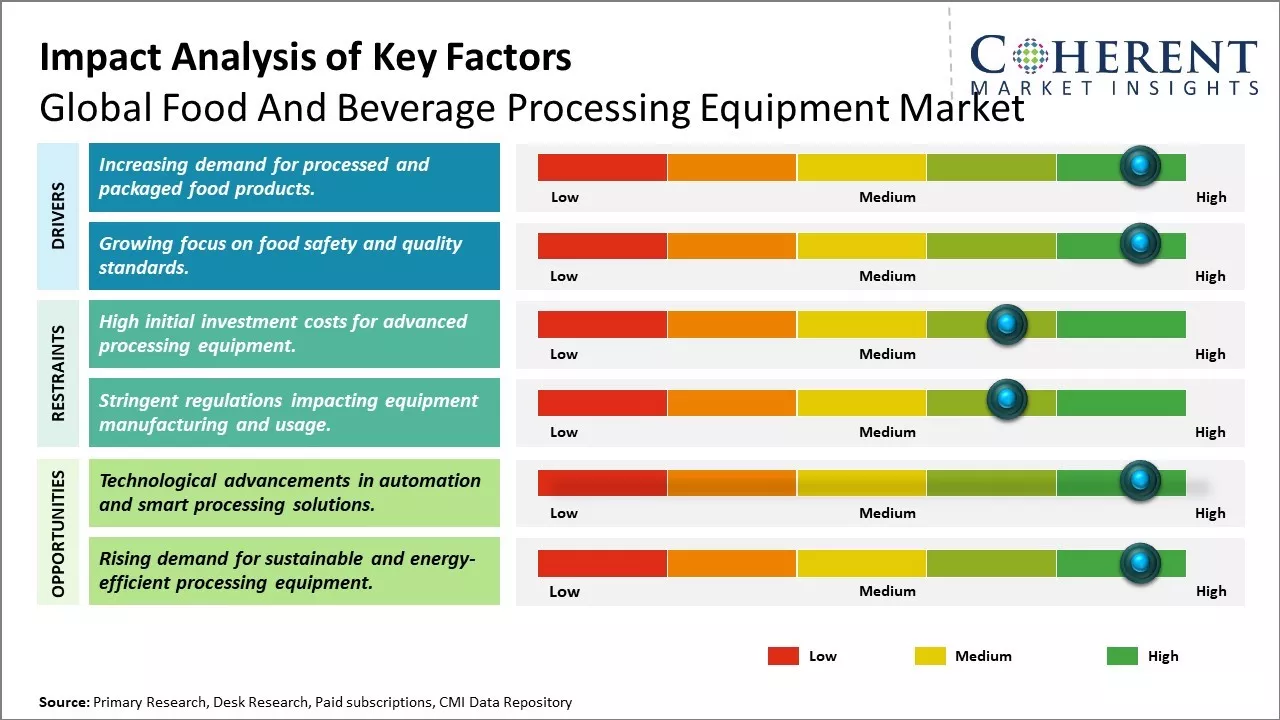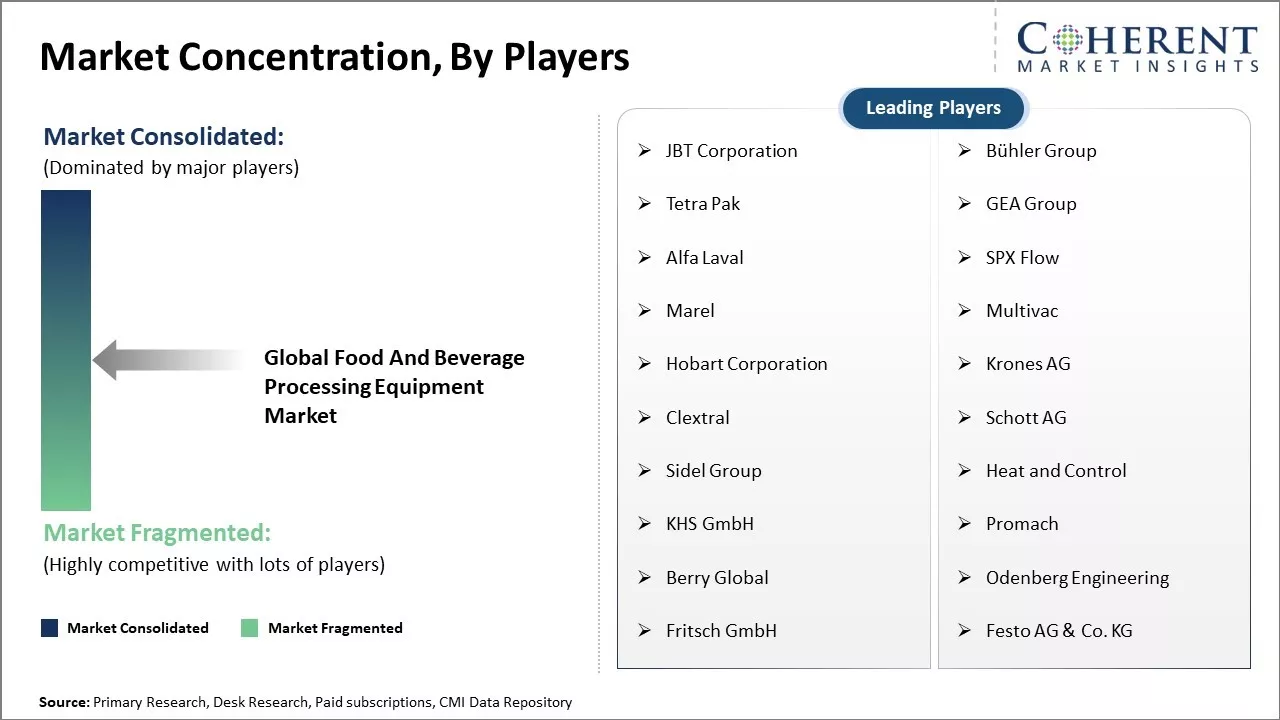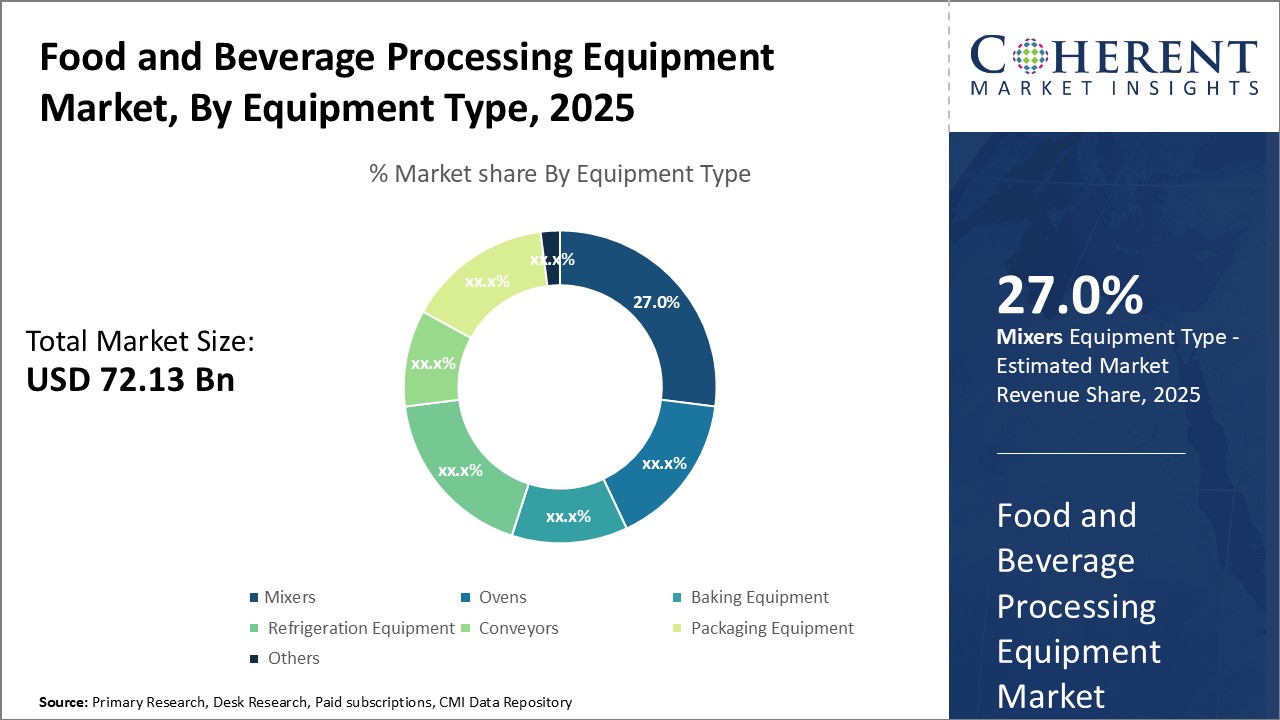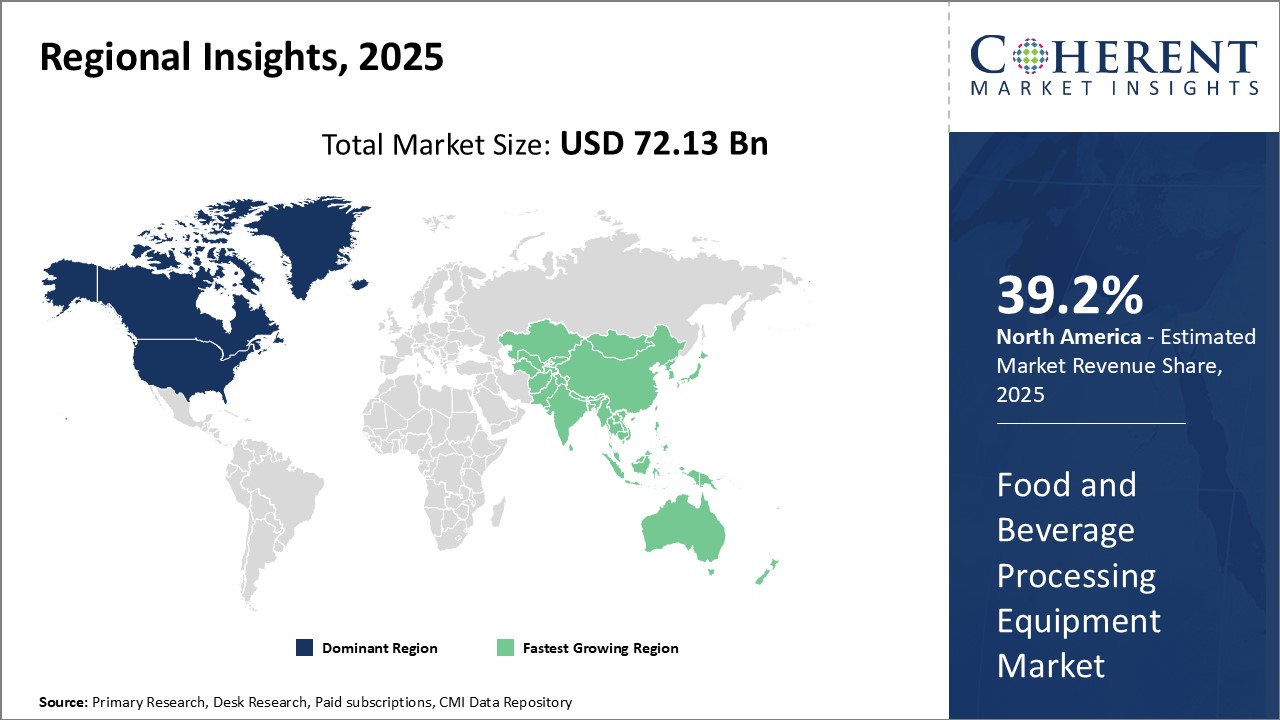Food And Beverage Processing Equipment Market Size and Trends
Global food and beverage processing equipment market is estimated to be valued at USD 72.13 Bn in 2025 and is expected to reach USD 106.39 Bn by 2032, exhibiting a compound annual growth rate (CAGR) of 5.7% from 2025 to 2032.

Discover market dynamics shaping the industry: Download Free Sample
The growing demand for packaged food & beverages due to changing lifestyles and busy schedules of consumers is driving significant investments in food processing machinery. The Global food and beverage processing equipment market is witnessing trends like growing automation and the development of technologically advanced equipment. Adoption of industrial internet of things solutions and integrating machines with advanced technologies like artificial intelligence and machine learning are allowing real-time process monitoring and optimization. Equipment manufacturers are focusing on production line upgrades, expanding capacities, and investing in research & development to cater to the dynamic needs of food processors.
Market Driver - Increasing demand for processed and packaged food products.
With rapid urbanization and changing lifestyle patterns across major economies such as United States, China and other, there is a significant rise in demand for packaged and processed food products among consumers. For instance, according to data by World Economic Forum released in 2023, predicts that the global Gross Domestic Product (GDP) will grow by 2.7% in 2023, with the modest improvement of 2.9% in 2025. People today lead very busy lives with long working hours and less time for cooking meals at home. This has augmented the popularity of ready-to-eat food options that can be prepared quickly. Moreover, growing disposable incomes are allowing consumers to spend more on quality packaged food items.
Manufacturers are catering to this need by introducing extensive ranges of snacks, frozen food, ready-to-cook mixes, dehydrated fruits and vegetables, baby food and other products that offer great convenience without compromising on taste and nutrition. They ensure high standards of hygiene and quality in processing food via sophisticated machinery. Production process involves cleaning, sorting, mixing, freezing, sealing, labeling, etc. Advanced equipment allows accurate weighing and mixing of ingredients, elimination of bacteria and microbes, maintenance of textures and flavors and long shelf-life of products.
Growing population in developing nations such as India and other is a key factor behind the surge in demand for packaged meals. With urban lifestyles and hectic work schedules, time-starved consumers rely on readymade options to fulfill their daily meal requirements effortlessly. Rising disposable incomes enables people to spend more on superior quality packaged bakery and dairy goods, juices, noodles and other processed snacks and beverages. This presents major opportunities for food and beverage processors to cater to untapped markets through infrastructural investments.
The food processing equipment industry caters extensively to the needs of food companies engaged in manufacturing packaged bakery items, milk powder, fruit juices, sauces, chips, frozen food, ready meals, and other products with long shelf life. Continuous use of automated machinery allows large scale, cost-effective production while meeting stringent hygiene criteria. Growing demand for convenient packaged food will persist, thereby propelling the market for advanced food processing machinery across the globe.
Market Concentration and Competitive Landscape

Get actionable strategies to beat competition: Download Free Sample
Growing Focus on Food Safety and Quality Standards
Ensuring food safety and quality has become a top priority for international regulatory bodies and consumers alike in recent years. Stringent regulations framed by organizations such as Food and Drug Administration, Food Safety and Standards Authority of India and European Food Safety Authority have compelled food processors to focus on sanitation, batch traceability and compliance. Equipment manufacturers are collaborating closely with laboratories to infuse latest technologies for identification, validation and rectification of potential microbiological, toxicological and contamination risks at all stages of food production.
Scandals involving contaminated imports have enhanced concerns about pathogens, impurities and toxicity prevalent in certain packaged food categories. This has driven processor innovation efforts towards robust systems for hazard analysis, critical control point’s management and employee training. Manufacturing lines rely heavily on automation and sensors for streamlined processes like precise sorting, washing, drying, packing under controlled conditions while optimizing resource usage. Real-time monitoring enables rapid recall in case of defects through centralized supervision.
Harmonizing global compliance parameters poses challenges due to variations in infrastructure, expertise and record keeping standards across jurisdictions. Governments also impose localized norms on microbiological criteria, chemical limits, labeling framework to protect domestic consumers. Hence suppliers focus on modularity, scalability, and efficiency without compromising stringent sanitation protocols acceptable worldwide.
As customers demand transparency into production practices and product ingredients sourcing, equipment caters to traceability needs through serialization, smart sensors in packaging lines. Blockchain ledgers allow tracking inputs from farm to table transparently. With foodborne outbreaks on the rise, it has become crucial to thoroughly screen raw materials and ensure validated kill steps and recalls are in place via robust computerized quality management. Robust equipment aligns manufacturers with new guidelines through advanced automation and controls.
Key Takeaways from Analyst:
Global food and beverage processing equipment market is poised to grow steadily over the next decade. Key drivers of growth include rising income levels in developing economies, increasing urbanization, and evolving consumer preferences toward convenience and packaged foods. Improving economic conditions will enable more consumers to shift toward higher value processed and packaged foods.
However, stringent food safety regulations pose a challenge to market players. Regulation is becoming stricter, particularly in North America and Europe, in order to ensure the quality and safety of food products. Equipment providers will need to continually innovate and develop solutions that meet evolving standards. High initial capital investments for modern processing lines can also restrain smaller players.
The North America region, is expected to dominate market growth. These economies are witnessing rapid expansion of their middle-class populations and food processing industries. North America will also see healthy gains as producers invest in newer technologies for added capacity and improved efficiency. The Middle East and Latin America present strong opportunities due to demographic shifts toward processed foods.
Market Challenge - High initial investment costs for advanced processing equipment
One of the key challenges faced by players in the global food and beverage processing equipment market is the high initial investment costs associated with advanced processing equipment. The latest technologies and industry 4.0 solutions for automation, packaging, and processing require heavy upfront capital expenditure. For emerging brands and companies in developing markets, procuring state-of-the-art machinery can be a significant financial burden. Additionally, faster upgrade cycles for processing solutions means that equipment has a shorter window for return on investment. High costs intensify pressure on food manufacturers to maximize productivity and throughput. While advanced technologies promise cost and time savings over the long run, many companies are deterred by the steep upfront expenses. The lack of financing options or credit further restricts procurement capability. This challenge is more pronounced in the current market conditions due to reduced risk appetite among investors and disruption caused by the global pandemic.
Market Opportunity - Technological advancements in automation and smart processing solutions
One key opportunity for players in the global food and beverage processing equipment market lies in continued technological advancements in the field of automation and smart processing solutions. Equipment designers are developing new systems with advanced robotics, Internet of Things connectivity, and machine learning and computer vision capabilities. Fully automated end-to-end production lines are gaining traction. Smart factories enabled by Industry 4.0 technologies promise higher yields, productivity, and product consistency compared to conventional facilities. Artificial intelligence and big data analytics can optimize processes, reduce waste, and enable predictive maintenance. Equipment manufacturers are also focusing on modularity and flexibility of machinery to support diversified production needs. Connected solutions facilitate remote monitoring and oversight. These technological developments are helping address issues of labor availability and skill while reducing operational costs for food companies over the long term. They are expected to drive overall modernization and upgrades in the processing equipment market.

Discover high revenue pocket segments and roadmap to it: Download Free Sample
Insights by Equipment Type: Versatility and widespread application across industries
In terms of equipment type, the mixers segment is estimated to contribute the highest market share of 27.0% in 2025. Mixers form the backbone of food and beverage processing owing to their versatility and ability to efficiently blend and mix dry, wet, and sticky ingredients. They are used across various stages of processing from initial blending and mixing of dry ingredients like flour, sugar, and cereals to blending liquids, sauces, and batters. They facilitate consistent mixing and help achieve the perfect texture, consistency, and uniformity required in final products.
Mixers are indispensable in industries that produce products ranging from bread, flour confectionaries, snacks and baked goods to sauces, spreads, dressings, and beverages. Their ability to thoroughly incorporate ingredients while controlling parameters like speed, time and intensity makes them well-suited for tasks like creaming butter and sugar, whipping egg whites, kneading dough, and emulsifying liquids and oils. Floor and planetary mixers are extensively used in large scale commercial bakeries to efficiently produce dough and batters for thousands of loaves and batches.
Continuous mixers like ribbon blenders are preferred for blending dry powdered ingredients like nutritional supplements, flavored salts and seasonings. Their efficient self-cleaning designs help switch between formulations quickly. Personal care products also use specialized mixers for tasks like blending exfoliants, pigments and herbal extracts. With ongoing demand for convenience foods and customized formulations across industries, mixers will continue dominating food processing equipment owing to their widespread application and flexibility.
Insights by End User: growing demand for packaged and processed foods
In terms of end user, the food processing segment is estimated to contribute the highest market share of 42.7% in 2025. The food processing sector has seen exponential growth over the past few decades driven by demand for packaged, preserved and ready-to-eat options. Rapid urbanization and changing lifestyles have boosted consumption of packaged foods, snacks and beverages globally. Food processing equipment forms a crucial part of the supply chain for industries producing breads, snacks, dairy products, juices, sauces and frozen meals.
Equipment like blenders, grinders, cutters, slicers, extruders and packaging machinery is integral for tasks ranging from ingredient preparation and portioning to forming, seasonings and final packaging. Conveyors efficiently transport food items between various processing stages. Freezers, chillers and temperature control units are widely used for cooling, freezing and shelf-life extension. Ovens and baking equipment Produce a variety consistently meet the production targets of bakeries and snack food manufacturers.
Rising health-consciousness is also fueling demand for whole-grain, multigrain and nutritional enriched products requiring specialized equipment. With growing emphasis on food safety and quality, processing equipment integrated with sensors and automation allows for real-time monitoring and standardized production. These trends will continue driving investments in technologically advanced and hygienic food processing machinery globally.
Regional Insights

Need a Different Region or Segment? Download Free Sample
North America has established itself as the dominant region in the global food and beverage processing equipment market. The region is expected to hold 39.2% of the market share in 2025. The presence of major food and beverage companies in the region along with strong demand from end-use industries such as dairy, meat, bakery, and snacks has led to North America. Major equipment suppliers have invested heavily in Research and Development (R&D) facilities and production capabilities in the region to cater to the exact needs of their clients. The customization abilities of these suppliers have helped win large contracts from leading food brands. Furthermore, supporting initiatives by governments in the U.S. and Canada to modernize food processing infrastructure through incentives and subsidies have boosted adoption of new technology and equipment upgrades.
Among growing regions, Asia Pacific is emerging as the fastest expanding market for food and beverage processing equipment globally. Rapid urbanization, rising health awareness and growing disposable incomes are fueling the demand for packaged and processed foods. For instance, according to data by the Economic Times released in March 2025, India's per capita disposable income is estimated at US$ 2,600 for the fiscal year 2024, marking an 8.5% increase from the previous year. This follows a substantial growth of 13.8% in the prior fiscal year. Countries such as India, China, Indonesia, and Vietnam are witnessing double digit growth in the processed food sectors annually. Local equipment manufacturers are partnering with global leaders to set up manufacturing units and gain technology know-how to tap the enormous opportunities. Additionally, private equity firms have significantly increased investments in building new food parks with end-to-end processing facilities. This is attracting international brands to establish local production and helping improve economies of scale. With strong fundamentals and supportive government initiatives, Asia Pacific is well positioned to surpass other regions in terms of absolute market value over the coming years.
Market Report Scope
Food and Beverage Processing Equipment Market Report Coverage
| Report Coverage | Details | ||
|---|---|---|---|
| Base Year: | 2024 | Market Size in 2025: | USD 72.13 Bn |
| Historical Data for: | 2020 To 2024 | Forecast Period: | 2025 To 2032 |
| Forecast Period 2025 to 2032 CAGR: | 5.7% | 2032 Value Projection: | USD 106.39 Bn |
| Geographies covered: |
|
||
| Segments covered: |
|
||
| Companies covered: |
JBT Corporation, Bühler Group, Tetra Pak, GEA Group, Alfa Laval, SPX Flow, Marel, Multivac, Hobart Corporation, Krones AG, Clextral, Schott AG, Sidel Group, Heat and Control, KHS GmbH, Promach, Berry Global, Odenberg Engineering, Fritsch GmbH, and Festo AG & Co. KG |
||
| Growth Drivers: |
|
||
| Restraints & Challenges: |
|
||
Uncover macros and micros vetted on 75+ parameters: Get instant access to report
Food and Beverage Processing Equipment Industry News
- In August 2023, Tetra Pak launched a new range of sustainable packaging solutions specifically designed for beverage processing. This innovative line reflects the company's commitment to sustainability and environmental responsibility in the food and beverage industry. By focusing on eco-friendly materials and processes, Tetra Pak aims to help manufacturers reduce their environmental impact while delivering high-quality packaging that meets consumer demands for sustainability.
- In July 2023, Bühler Group expanded its facility in Switzerland to enhance its food processing capabilities. This expansion is part of the company's strategy to meet the growing demand for innovative and efficient food production solutions. By upgrading its facilities, Bühler aims to improve operational efficiency and support the development of advanced technologies that cater to the evolving needs of the food industry, ultimately contributing to global food security.
- In May 2023, GEA Group, a global technology company collaborated with a tech startup to develop automated food processing solutions. This partnership aims to leverage cutting-edge technology to enhance efficiency and precision in food production. By integrating automation into their processes, GEA Group seeks to improve operational performance and meet the increasing demands of the food industry for innovative and scalable solutions. This collaboration underscores GEA Group's commitment to advancing food processing technologies for a more sustainable future.
- In March 2023, Marel acquired a technology firm to bolster its product offerings in meat processing. This strategic acquisition aims to enhance Marel's capabilities in delivering innovative solutions that improve efficiency and quality in the meat industry. By integrating advanced technologies from the acquired firm, Marel is positioned to strengthen its market presence and provide customers with cutting-edge tools that meet the evolving demands of meat processing.
*Definition: The global food and beverage processing equipment market consists of machinery and other processing equipment used in food processing, beverage production, and packaging industries. This includes equipment such as depositors, fillers, sealers, peelers, grinders, mixers, blenders, homogenizers, separators, sorting machines, ovens and thermal equipment, and process analyzers. The food and beverage processing equipment are used to produce, handle, package and distribute various food items and beverages on a commercial scale.
Market Segmentation
- By Equipment Type Insights (Revenue, USD Bn, 2020 - 2032)
-
- Mixers
- Ovens and Baking Equipment
- Refrigeration Equipment
- Conveyors
- Packaging Equipment
- Others
- By End User Insights (Revenue, USD Bn, 2020 - 2032)
-
- Food Processing
- Beverage Processing
- Regional Insights (Revenue, USD Bn, 2020 - 2032)
- North America
- U.S.
- Canada
- Latin America
- Brazil
- Argentina
- Mexico
- Rest of Latin America
- Europe
- Germany
- U.K.
- Spain
- France
- Italy
- Russia
- Rest of Europe
- Asia Pacific
- China
- India
- Japan
- Australia
- South Korea
- Central Africa
- ASEAN
- Rest of Asia Pacific
- Middle East
- GCC Countries
- Israel
- Rest of Middle East
- Africa
- South Africa
- North Africa
- North America
- Key Players Insights
-
- JBT Corporation
- Bühler Group
- Tetra Pak
- GEA Group
- Alfa Laval
- SPX Flow
- Marel
- Multivac
- Hobart Corporation
- Krones AG
- Clextral
- Schott AG
- Sidel Group
- Heat and Control
- KHS GmbH
- Promach
- Berry Global
- Odenberg Engineering
- Fritsch GmbH
- Festo AG & Co. KG
Share
Share
About Author
Yash Doshi is a Senior Management Consultant. He has 12+ years of experience in conducting research and handling consulting projects across verticals in APAC, EMEA, and the Americas.
He brings strong acumen in helping chemical companies navigate complex challenges and identify growth opportunities. He has deep expertise across the chemicals value chain, including commodity, specialty and fine chemicals, plastics and polymers, and petrochemicals. Yash is a sought-after speaker at industry conferences and contributes to various publications on topics related commodity, specialty and fine chemicals, plastics and polymers, and petrochemicals.
Missing comfort of reading report in your local language? Find your preferred language :
Transform your Strategy with Exclusive Trending Reports :
Frequently Asked Questions
EXISTING CLIENTELE
Joining thousands of companies around the world committed to making the Excellent Business Solutions.
View All Our Clients
